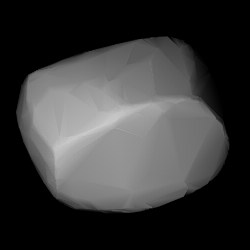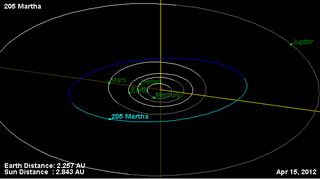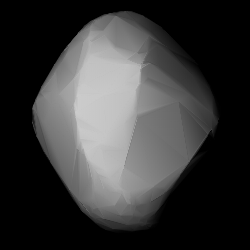Related Research Articles

Lomia is a large main-belt asteroid that has a nearly circular orbit; the orbital eccentricity is 0.029. It was discovered by French astronomer Alphonse Borrelly on September 12, 1871, from the Marseilles Observatory. The preliminary orbital elements were published in the following year by German astronomer Friedrich Tietjen. The reason for the name is uncertain, but Lutz D. Schmadel believes it is most likely a misspelling of Lamia, the female demon of Greek mythology.

Menippe is a main belt asteroid. The object has a bright surface and rocky composition. It was discovered by C. H. F. Peters on June 18, 1878, in Clinton, New York, and named after Menippe, one of the daughters of Orion in Greek mythology.

Martha is a large main belt asteroid. It is a dark, primitive carbonaceous C-type asteroid. This object was discovered by Johann Palisa on 13 October 1879, in Pola and was named after Martha, a woman in the New Testament.

Medea is a very large main-belt asteroid that was discovered by Johann Palisa on February 6, 1880, in Pola, and was named after Medea, a figure in Greek mythology.

Lilaea is a large main belt asteroid. It was discovered by German-American astronomer C. H. F. Peters on February 16, 1880, in Clinton, New York and was named after Lilaea, a Naiad in Greek mythology.

Lucia is a large Themistian asteroid. It was discovered by Johann Palisa on 9 February 1882 in Vienna and named after Lucia, daughter of Austro-Hungarian explorer Graf Wilczek.

Gordonia is a fairly typical, although sizeable Main belt asteroid.
Petrina is a minor planet orbiting the Sun.
Kressida is a minor planet orbiting the Sun. This object was discovered by German astronomer Paul Götz in 1904. It is named after the theatrical character Cressida. This stony S-type asteroid is orbiting at a distance of 2.28 AU from the Sun, with an orbital eccentricity (ovalness) of 0.185 and a period of 3.45 yr. The orbital plane is inclined at an angle of 3.87° to the ecliptic.
Bilkis is a minor planet, specifically an asteroid orbiting in the asteroid belt. It was discovered by German astronomer August Kopff in 1906 February and was given the Koran name for the Queen of Sheba. Photometric observations at the Palmer Divide Observatory in Colorado Springs, Colorado in 2006–7 were used to build a light curve for this object. The asteroid displayed a rotation period of 8.5742 ± 0.0005 hours and a brightness variation of 0.40 ± 0.02 in magnitude.

Juvisia is a minor planet, specifically an asteroid orbiting in the asteroid belt that was discovered 27 August 1906 in Heidelberg by German astronomer Max Wolf. It was named after the commune Juvisy-sur-Orge, France, where French astronomer Camille Flammarion had his observatory.
608 Adolfine is a minor planet, specifically an asteroid orbiting in the asteroid belt.
620 Drakonia is a minor planet, specifically an asteroid orbiting in the asteroid belt. It was discovered October 26, 1906, in Taunton, Massachusetts, by American astronomer Joel Hastings Metcalf and given the preliminary designation 1906 WE. It may have been named for Drake University.
650 Amalasuntha is a minor planet orbiting the Sun that was discovered by German astronomer August Kopff on October 4, 1907, at Heidelberg. It was named after Amalasuntha, the queen of the Ostrogoths from 526 to 534 AD. The name may have been inspired by the asteroid's provisional designation 1907 AM.
678 Fredegundis is a minor planet orbiting the Sun. It was discovered 22 January 1909 from Heidelberg by German astronomer K. Wilhelm Lorenz, and was named after the French opera Frédégonde. This object is orbiting at a distance of 2.57 AU with a period of 4.13 years and an eccentricity (ovalness) of 0.22. The orbital plane is inclined at an angle of 6.1° to the plane of the ecliptic
687 Tinette is a minor planet, specifically an asteroid orbiting primarily in the asteroid belt. It was discovered by Austrian astronomer Johann Palisa on 16 August 1909 from Vienna and was given the preliminary designation 1909 HG.
707 Steina is a minor planet, specifically an asteroid orbiting in the asteroid belt.
710 Gertrud is a Themistian asteroid, which means it is a member of the Themis family of asteroids. It was discovered by Austrian astronomer Johann Palisa on 28 February 1911 from Vienna.
793 Arizona is a minor planet orbiting the Sun that was discovered April 9, 1907 by American businessman Percival Lowell at Flagstaff. It was named for the state of Arizona. The object was independently discovered on April 17, 1907, by J. H. Metcalf at Taunton. This is a main belt asteroid orbiting 2.8 AU from the Sun with a period of 4.675 yr and an eccentricity (ovalness) of 0.13. The orbital plane is inclined at an angle of 15.8° to the plane of the ecliptic.
6144 Kondojiro (1994 EQ3) is an asteroid discovered on March 14, 1994 by Kin Endate and Kazuro Watanabe at the Kitami Observatory in eastern Hokkaidō, Japan. It is named after Jiro Kondo, a Japanese Egyptologist and professor of archaeology at Waseda University.
References
- 1 2 Yeomans, Donald K., "530 Turandot", JPL Small-Body Database Browser, NASA Jet Propulsion Laboratory , retrieved 5 May 2016.
- 1 2 3 di Martino, M.; et al. (July 1995), "Intermediate size asteroids: Photoelectric photometry of 8 objects.", Astronomy and Astrophysics Supplement, vol. 112, pp. 1–7, Bibcode:1995A&AS..112....1D.